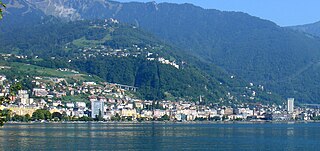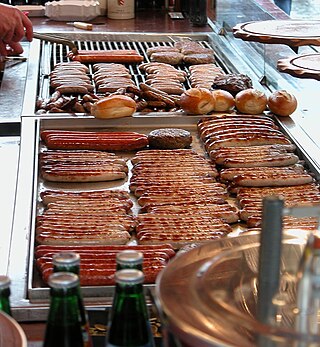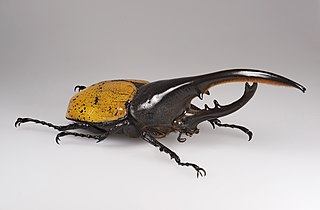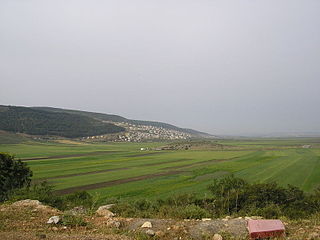
Montreux is a Swiss municipality and town on the shoreline of Lake Geneva at the foot of the Alps. It belongs to the district of Riviera-Pays-d'Enhaut in the canton of Vaud in Switzerland, and has a population of approximately 26,433, with about 85,000 in the agglomeration Vevey-Montreux as 2019.

The Eurasian carp or European carp, widely known as the common carp, is a widespread freshwater fish of eutrophic waters in lakes and large rivers in Europe and Asia. The native wild populations are considered vulnerable to extinction by the International Union for Conservation of Nature (IUCN), but the species has also been domesticated and introduced into environments worldwide, and is often considered a destructive invasive species, being included in the list of the world's 100 worst invasive species. It gives its name to the carp family, Cyprinidae.

Biological control or biocontrol is a method of controlling pests, whether pest animals such as insects and mites, weeds, or pathogens affecting animals or plants by using other organisms. It relies on predation, parasitism, herbivory, or other natural mechanisms, but typically also involves an active human management role. It can be an important component of integrated pest management (IPM) programs.

Bratwurst is a type of German sausage made from pork or, less commonly, beef or veal. The name is derived from the Old High German Brätwurst, from brät-, finely chopped meat, and Wurst, sausage, although in modern German it is often associated with the verb braten, to pan fry or roast. Beef and veal are usually incorporated amongst a blend often including pork. Beef or veal is usual in halal and kosher Bratwurst sausages, which never include pork for religious reasons.

The Colorado potato beetle is also known as the Colorado beetle, the ten-striped spearman, the ten-lined potato beetle, or the potato bug. It is a major pest of potato crops. It is about 10 mm long, with a bright yellow/orange body and five bold brown stripes along the length of each of its elytra. Native to the Rocky Mountains, it spread rapidly in potato crops across America and then Europe from 1859 onwards.

The Upper Silesia plebiscite was a plebiscite mandated by the Versailles Treaty and carried out on 20 March 1921 to determine ownership of the province of Upper Silesia between Weimar Germany and Poland. The region was ethnically mixed with both Germans and Poles; according to prewar statistics, ethnic Poles formed 60 percent of the population. Under the previous rule by the German Empire, Poles claimed they had faced discrimination, making them effectively second class citizens. The period of the plebiscite campaign and inter-Allied occupation was marked by violence. There were three Polish uprisings, and German volunteer paramilitary units came to the region as well.

The common cockchafer, also colloquially known as the Maybug, Maybeetle, or doodlebug, is a species of scarab beetle belonging to the genus Melolontha. It is native to Europe, and it is one of several closely-related and morphologically similar species of Melolontha called cockchafers, alongside Melolontha hippocastani.

Melolontha hippocastani, the northern cockchafer, is a species of scarab beetle native to Eurasia, with its range spanning from Western Europe to the Pacific coast of China. It is one of several species in the genus Melolontha known as cockchafers, alongside the common cockchafer and Melolontha pectoralis, but generally at more northern latitudes, or at higher altitudes in upland woods further south. The adults are around 20–29 mm in length. It is distinguished from Melolontha melolontha by the shape of its pygidium, which is primarily black in colour. It primarily dwells in forests, and as such is also known as the forest cockchafer. The mate-finding behaviour in M. hippocastani is facilitated by plant volatiles and sex pheromones. Mating activities primarily takes place during the evening flight periods. Females lay their eggs in soil, and the larvae feed on decaying organic matter and later small plant roots, including the roots of young trees like pines and firs. The larvae usually develop between 3 and 5 years. They emerge between late April and the end of June. Like other cockchafers, they have been considered a serious pest of crops and trees.

The Standard Superior was an automobile, produced from 1933 to 1935 by Standard Fahrzeugfabrik of Ludwigsburg, Germany, founded by motorcycle maker Wilhelm Gutbrod and unrelated to the Standard Motor Company of England. These small cars were designed according to the patents by Josef Ganz and featured rear-mounted two-stroke engines.

Josef Ganz was a Jewish-German car designer born in Budapest, Austro-Hungarian Empire.

The Hercules beetle is a species of rhinoceros beetle native to the rainforests of southern Mexico, Central America, South America, and the Lesser Antilles. It is the longest extant species of beetle in the world, and is also one of the largest flying insects in the world.

Immigration to Germany, both in the country's modern borders and the many political entities that preceded it, has occurred throughout the country's history. Today, Germany is one of the most popular destinations for immigrants in the world, with well over 1 million people moving there each year since 2013. As of 2019, around 13.7 million people living in Germany, or about 17% of the population, are first-generation immigrants.

Catalans are a Romance ethnic group native to Catalonia, who speak Catalan. The current official category of "Catalans" is that of the citizens of Catalonia, an autonomous community in Spain and the inhabitants of the Roussillon historical region in southern France, today the Pyrénées Orientales department, also called Northern Catalonia and Pays Catalan in French.

The Swiss people are the citizens of the multi-ethnic Swiss Confederation (Switzerland) regardless of ethno-cultural background or people of self-identified Swiss ancestry.

Immigration to Europe has a long history, but increased substantially after World War II. Western European countries, especially, saw high growth in immigration post 1945, and many European nations today have sizeable immigrant populations, both of European and non-European origin. In contemporary globalization, migrations to Europe have accelerated in speed and scale. Over the last decades, there has been an increase in negative attitudes towards immigration, and many studies have emphasized marked differences in the strength of anti-immigrant attitudes among European countries.

Bu'eine Nujeidat is an Arab local council in the Northern District of Israel. Made up of two villages, Bu'eine and Nujeidat, they merged in 1987 and were recognized as one local council in 1996. In 2022 its population was 10,289, the majority of which is Muslim.

Maikäfer was the nickname of an automobile prototype, built in 1931 by German engineer Josef Ganz at Adler.
Entomological warfare (EW) is a type of biological warfare that uses insects to interrupt supply lines by damaging crops, or to directly harm enemy combatants and civilian populations. There have been several programs which have attempted to institute this methodology; however, there has been limited application of entomological warfare against military or civilian targets, Japan being the only state known to have verifiably implemented the method against another state, namely the Chinese during World War II. However, EW was used more widely in antiquity, in order to repel sieges or cause economic harm to states. Research into EW was conducted during both World War II and the Cold War by numerous states such as the Soviet Union, United States, Germany and Canada. There have also been suggestions that it could be implemented by non-state actors in a form of bioterrorism. Under the Biological and Toxic Weapons Convention of 1972, use of insects to administer agents or toxins for hostile purposes is deemed to be against international law.

HMS Cockchafer was a Royal Navy Insect-class gunboat. She was built by Barclay Curle and launched on 17 December 1915 as the fifth Royal Navy ship to carry this name. The Insect class was originally designed for service on the River Danube but most of them spent much of their service on Chinese rivers.

Wiener schnitzel, sometimes spelled Wienerschnitzel, is a type of schnitzel made of a thin, breaded, pan-fried veal cutlet served with ample quantities of sauce.



















